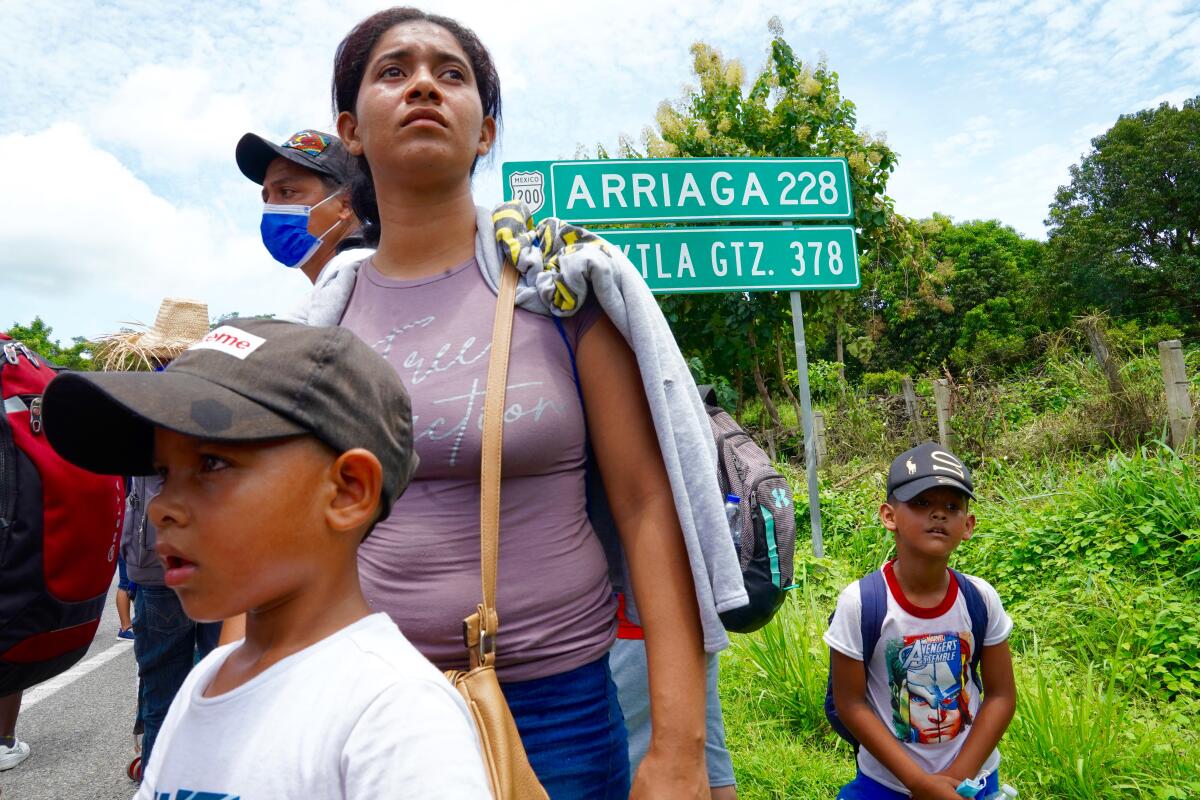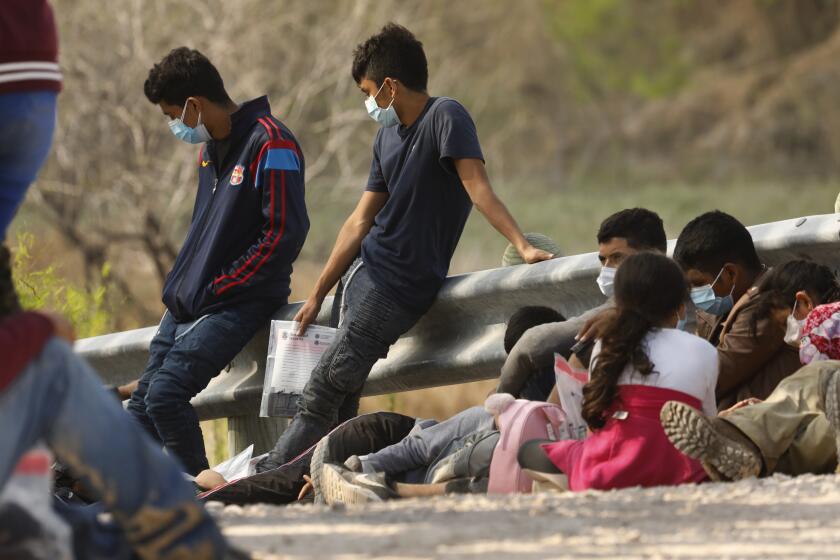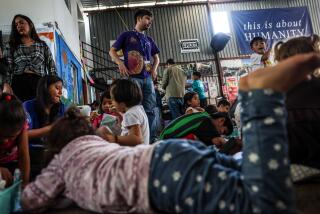Title 42 explained: The obscure public health policy at the center of a U.S. border fight

WASHINGTON — At the center of today’s most heated immigration debate is a decades-old health statute dusted off by the Trump administration that is reshaping U.S. policy at the border.
Citing the threat of COVID-19, the U.S. government has over the last year and a half carried out nearly 1.3 million expulsions of migrants at the border without offering them the opportunity to request asylum or other humanitarian protections. That policy — known as Title 42 for the section of the health statute where it originated — has been met with legal and political challenges, but it remains on the books.
And it’s one of the main reasons that border crossings are up. According to CBP data released in October, there were 1.7 million people detained at the Southwest border during fiscal year 2021, which ended Sept. 30. This year marked the largest annual total for apprehensions in Border Patrol history. That’s in part because the nature of the rapid Title 42 expulsions make it easier for people to try to immediately cross again.
Here’s why Title 42 matters, and what you need to know.
What is Title 42?
Title 42 is a public health and welfare statute enacted in 1944 that gave the U.S. surgeon general the authority — later transferred to the Centers for Disease Control and Prevention — to determine whether communicable disease in a foreign country poses a serious danger of spreading in the U.S., either by people or property entering the country.
If the CDC finds that a disease does pose a threat, it can, with approval from the president, temporarily prohibit them from entering the country to avert danger.
That’s just what it did at the beginning of the COVID-19 pandemic. In March 2020, amid surging deaths from disease, the Trump administration put forward a novel interpretation of Title 42: U.S. Customs and Border Protection agents could immediately remove anyone entering the country without authorization to prevent the spread of the coronavirus. This new interpretation of policy closed the border to nonessential travel in the “interest of public health.”
But it also superseded all other U.S. laws, including statutes that grant migrants the right to seek asylum; prevent the persecuted from being returned to countries where they would face threats, harm or torture; and protect unaccompanied children vulnerable to being trafficked.
Before the Trump administration, migrants who made it to the U.S. and sought asylum or other humanitarian protections were detained or released into the country pending a final immigration court decision, which could take years amid a growing backlog of cases.
Under Title 42, migrants do not even receive a formal order of deportation. Instead, agents take migrants’ biometric information and perform a cursory health check for COVID-19 symptoms — a process that can take roughly 90 minutes — before returning them to Mexico (if they are from Mexico or Central America). If they are from anywhere else, they are typically flown back there.
How did we get here?
The Title 42 policy appears to have been first applied by the CDC under pressure from former Vice President Mike Pence, and from Stephen Miller, a top Trump aide who long sought to restrict immigration. Experts at the CDC objected, saying the policy would do little to stanch the spread of the coronavirus and that it could not be justified in the name of public health. Pence ordered the CDC’s director to use the agency’s emergency powers to effectively seal the U.S. borders anyway.
Advocacy groups including the ACLU last year sued the Trump administration over its use of Title 42. When President Biden began his term in January, the new administration continued the policy, saying it is “necessary to limit the spread of the coronavirus.”
The Biden administration says migrants can still get protection under a Trump-era pandemic policy. But in a year, fewer than 1% have been able to do so.
After 16,000 children who were traveling without a parent had been expelled from the U.S. under Title 42, the Biden administration exempted unaccompanied minors from the policy. Parents traveling with their children and single adults are still officially blocked from entering the country or are quickly expelled. But children traveling with extended family members, such as grandparents, are not considered family units, meaning they can be separated at the border with the children labeled as unaccompanied minors and allowed to enter.
Advocates expected the president to rescind the order over the summer, as COVID-19 restrictions were lifted. But then the Delta variant hit.
What’s the controversy?
Legal experts say Title 42 is one of the most controversial and restrictive immigration policies ever enacted. When the Trump administration implemented Title 42, lawmakers including then-Sen. Kamala Harris called it an unconstitutional “executive power grab.” Immigrant advocates broadly expected Biden to do away with enforcement of the measure when he took office.
Public health experts say people who refuse to get vaccinated — not migrants — are driving the increase of infections in the U.S. Last month, former CDC officials wrote a letter to the Biden administration condemning the current policy as “scientifically baseless and politically motivated.” They said that measures including masking, social distancing, quarantine and vaccination effectively prevent the spread of COVID-19.
Dr. Anthony Fauci, the nation’s top infectious disease expert, said Oct. 3 on CNN that immigrants are “absolutely not” a driving force of COVID-19. Asked about Title 42, Fauci said, “My feeling has always been that focusing on immigrants, expelling them ... is not the solution to an outbreak.”
The Department of Homeland Security announced that some restrictions on non-essential travel at land ports of entry will be lifted in November, allowing vaccinated people to enter the U.S. from Canada and Mexico. Asked how officials could justify continuing Title 42 while ending restrictions at ports of entry, a senior Biden administration official said that two different populations are at issue — those entering with prior authorization and those entering without.
The administration continues to maintain that the Title 42 restrictions protect the migrants themselves, the DHS workforce and local communities.
How is Title 42 different from ‘Remain in Mexico’?
Sometimes the Title 42 policy is confused with another Trump administration policy known as the Migrant Protection Protocols, or MPP, more commonly referred to as “Remain in Mexico.” Under that 2019 policy, U.S. immigration officers direct migrants from countries other than Mexico to stay there while their cases weave through the immigration court system.
The program has resulted in thousands of migrants living in squalid tent encampments on the Mexican side of the border in some of the world’s most dangerous cities. But it still gives migrants the chance to apply for asylum, albeit from outside the U.S.
Title 42 prevents them from seeking humanitarian protections at all.
Border authorities under the Trump administration largely stopped using Migrant Protection program at the beginning of the pandemic in favor of Title 42, and Biden officially ended the policy soon after taking office. But a federal court in Texas ruled that he must restart it. The Supreme Court later upheld that decision.
DHS said in September that it is still committed to ending the policy in a manner that addresses the court’s concerns. In the meantime, officials are preparing to reimplement the policy in mid-November as long as the Mexican government agrees to once again accept asylum seekers with pending cases.
How is Title 42 working?
Among more than 1.7 million people detained by CBP at the Southwest border during fiscal year 2021, 61% were expelled under Title 42, according to CBP data released Friday. But those rapid expulsions caused a significant increase in repeated crossing attempts by migrants returned to Mexico, inflating the number of individuals encountered. In recent months, including September, upwards of a quarter of the arrests were by people who had previously been turned back within the same year.
While migrants can’t seek asylum under Title 42, they can still be screened under the United Nations Convention Against Torture. Just 272, or 8%, passed their initial screenings. These screenings, in which migrants must prove that they are likely to be tortured if they are expelled, are more difficult to pass than traditional asylum interviews.
Federal officials rely on Mexico to receive migrants expelled from the U.S. under Title 42 who are from Central America, the Caribbean and elsewhere. Many migrants who are refused by Mexico and cannot be immediately expelled are held in detention while they await a longer deportation process.
Early this year, the Mexican state of Tamaulipas, which borders Texas, started refusing to accept families with young children. Since then, CBP has transferred some migrants to other Mexican border cities. But most families encountered near there are now sent to U.S. detention centers or released in Texas. Thousands of others have been flown to southern Mexico and then expelled by the Mexican government to Guatemala or Honduras.
Where does the legal battle stand?
The CDC issued an order in August keeping Title 42 in place. Early this month the agency completed another assessment and determined it continues to be necessary.
Last month, in response to the ACLU’s lawsuit, a U.S. district judge in Washington, D.C., found that migrant families subjected to Title 42 “face real threats of violence and persecution” and are deprived of statutory rights to seek protection in the U.S. The judge also found that, while Title 42 grants the government the authority to turn away people seeking to enter the country, it does not permit expulsions of people already on U.S. soil.
Justice Department lawyers argued in a court filing afterward that halting Title 42 would require the government to detain people for immigration processing “in facilities that are not equipped for physical distancing, quarantine, or isolation at the best of times, and that are now substantially over their COVID-restricted capacity.” A federal appellate court later temporarily granted the Biden administration permission to continue the use of Title 42 to quickly expel migrants with children stopped along the U.S. border.
Former CDC officials say that most asylum seekers don’t have to be held in detention for health reasons, and that transferring detainees between facilities, as is often done before deporting them, increases the risk of COVID-19 transmission.
The nonprofit group Human Rights First has tracked at least 7,647 kidnappings, rapes and other attacks on people expelled or blocked at the U.S.-Mexico border since Biden took office, including multiple children raped at tent encampments in Tijuana and Reynosa, in the Rio Grande Valley.
Though it’s still early, the September order by the appellate court offers an indication of how it could ultimately rule. If the Biden administration wins its appeal, it could continue to use Title 42 for immigration enforcement. But even if it loses, the administration could still appeal to the Supreme Court, where a conservative majority might be inclined to side with federal officials.
The CDC’s next 60-day assessment of the policy is Dec. 2.
Times staff writer Molly O’Toole contributed to this report.
More to Read
Get the L.A. Times Politics newsletter
Deeply reported insights into legislation, politics and policy from Sacramento, Washington and beyond. In your inbox three times per week.
You may occasionally receive promotional content from the Los Angeles Times.














